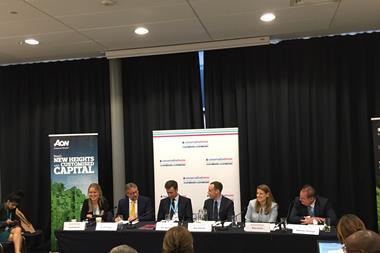Aon offers its broker’s-eye-view on chief executive John Neal’s plans for the future at Lloyd’s, ahead of its blueprint publication on 30 September
Lloyd’s is at a pivotal moment, and chief executive John Neal’s ‘Future at Lloyd’s’ initiative may result in the biggest changes in the market since Reconstruction and Renewal in the mid-1990s reports Insurance Times’s sister publication Global Reinsurance.
This is according to Aon’s new report on Lloyd’s.
Three years since the broker last gave its view on Lloyd’s, the new publication comes at what Aon calls “a pivotal moment in Lloyd’s evolution”. The market awaits a blueprint to be published on 30 September for the ”new Lloyd’s”, designed to result in a bigger and more efficient marketplace.

In October work will begin on building prototypes and delivering full services, some of which Lloyd’s expects to be operational early in 2020, prioritising a new complex risk platform and a transformed claims service.
Top and bottom of the class
Impetus for change at Lloyd’s stems from weak underwriting performance. The ‘Decile 10’ initiative saw Lloyd’s take the axe to under-performing business in 2018.
Lloyd’s is also intent on squeezing the market’s expense ratio, which has averaged around 40% over the last five years putting it at a disadvantage.
Management expects the remediation plans already in place to bring the market back to profit in 2019, allowing for major losses equivalent to 9% of net premium earned, said Aon’s report.
Greater differentiation is being seen in Lloyd’s treatment of syndicates, Aon observed. Top-quartile performers now benefit from a ‘light touch’ regime, while loss-making businesses remain under pressure and subject to constraints.
This has spurred consolidation within Lloyd’s, which Aon expects to continue.
“Lloyd’s has had to make some difficult adjustments to address the deterioration in underlying performance exposed by the major losses in 2017 and 2018,” said Nick Frankland, Aon’s UK chief executive for its reinsurance solutions business. “This remains a work in progress, but in the interim we applaud the vision for the ‘Future at Lloyd’s’ that has been laid out by John Neal and his executive team.”
Feedback to proposals
Neal’s proposals to transform Lloyd’s are ambitious, Aon said, designed to result in a much more efficient and responsive market. The goal is to create better connectivity between capital and risk that delivers greater value to customers and supports long-term growth, the broker noted.
Lloyd’s offered six proposals in May: a platform for complex risk involving digital placement; an automated ‘Lloyd’s Risk Exchange’ for buying cover for less complex risks. a platform that provides an easy way for capital to access a diverse set of insurance risks; ‘Syndicate-in-a-Box’ for high-performing firms to fast-track access to underwriting innovative business; a next generation claims service; and an ecosystem of services.
Phase one consultation ended on 10 July. “The approach has been collaborative, and the feedback has been positive,” Aon’s report said. “[Phase 1] generated 4,000 responses over a 10-week period, with around 75% of respondents said to support the overall strategy and around 65% supporting each of the six initiatives.”
Looking to the upcoming blueprint taking that feedback into account, Aon’s list of potential outcomes includes: separate placement methods for complex and standardised risks; easier entry to the market for high-performing innovative businesses; more flexibility in the way that capital participates; a next-generation claims service; and the creation of an ‘ecosystem’ of data and services.
Advisory committees created and internal resources mobilised still leave some execution risk. “Redefining the market will require collaborative effort from all participants, substantial investment and the acceptance of significant cultural change,” Aon warned.
Positive outcomes
An onus on leaders underpins the initiative, to burnish the Lloyd’s reputation for risk expertise and innovation. It also aims to foster a ‘tracker’ following market – including third party capital – that avoids duplication of effort.
“Leaders will be rewarded for investing in differentiated underwriting, partly via fee income for services provided, while pure followers will be allowed to operate without underwriting, claims or compliance teams i.e. at much lower cost,” Aon said.
There is also the Risk Exchange for simpler covers. “This will allow a single broker to place a risk from anywhere in the world, review the options, quote the price and bind, all on a single standardised platform. The complex risk platform will support face-to-face negotiations by providing an automated back office to boost speed and efficiency,” Aon said.
Greater capital flexibility is envisaged for MGAs if the Risk Exchange can streamline their business processes, while the Syndicate-in-a-Box idea also provides a possible low-cost Lloyd’s entry route.
“Investors that have previously found Lloyd’s ‘too difficult’ will be encouraged by John Neal’s desire to create a marketplace that can be open to different types of capital and have different return expectations and different risk time horizons,” said Aon.
“Lloyd’s believes the proposed measures have the potential to allow acquisition and administration costs for the most common risks to be cut from 30-40% today to 10-20% within five years and the time taken from request to bind and policy issuance to be cut from weeks to days,” the broker added.
Hosted by comedian and actor Tom Allen, 34 Gold, 23 Silver and 22 Bronze awards were handed out across an amazing 34 categories recognising brilliance and innovation right across the breadth of UK general insurance.




















































No comments yet